Source: Creative Commons
The sun seen with a small telescope
How the Technosphere Can Make the Earth More Active
As physicist and Earth System scientist Axel Kleidon argues, the future evolution of humans and their technosphere is not a random, unpredictable outcome. Rather, the technosphere might represent the thermodynamic imperative of advancing the Earth system to higher levels of activity with greater energy conversion. Could it be said that with the development of the technosphere, the Earth is currently undergoing a shift to a state of greater activity?
The Technosphere Needs Energy to Be Active
Energy is central for the technosphere to be active and do things. Just like humans who need energy to maintain their metabolisms even when they sleep and do nothing, any technical object requires energy to be created, to be maintained, and to be able to do things. This energy can come in different forms. Humans get their energy in the form of calories from the food they eat. A power plant gets its energy in chemical form from the coal it burns, while a toaster or a computer uses electric energy that was generated by a power plant. I use the term “active” here to refer to this continuous need for energy to do things. It is a basic need at a profound level for the technosphere, for humans, for the whole biosphere, and, in fact, for any Earth system process to be able to do things.
Focusing on energy makes the activity of humans and their technosphere comparable to the activity of other Earth system processes. I approach this from a purely physical—or, more precisely, thermodynamic—perspective. Overall, this approach allows us to generalize, to identify evolutionary directions and basic limits, and to weave these activities that seem so different from purely natural processes into the context of the Earth system. After all, the energy used by humans and their technosphere needs to come from somewhere within the Earth system, and their activities do something that ultimately alters this very same entity. By tracing energy through the Earth system back to human activity and the technosphere, one can link these processes together and view them in the context of the functioning of the whole planetary system. We can then appreciate the basic role of humans and their technosphere and get a glimpse of what we can expect of the future.
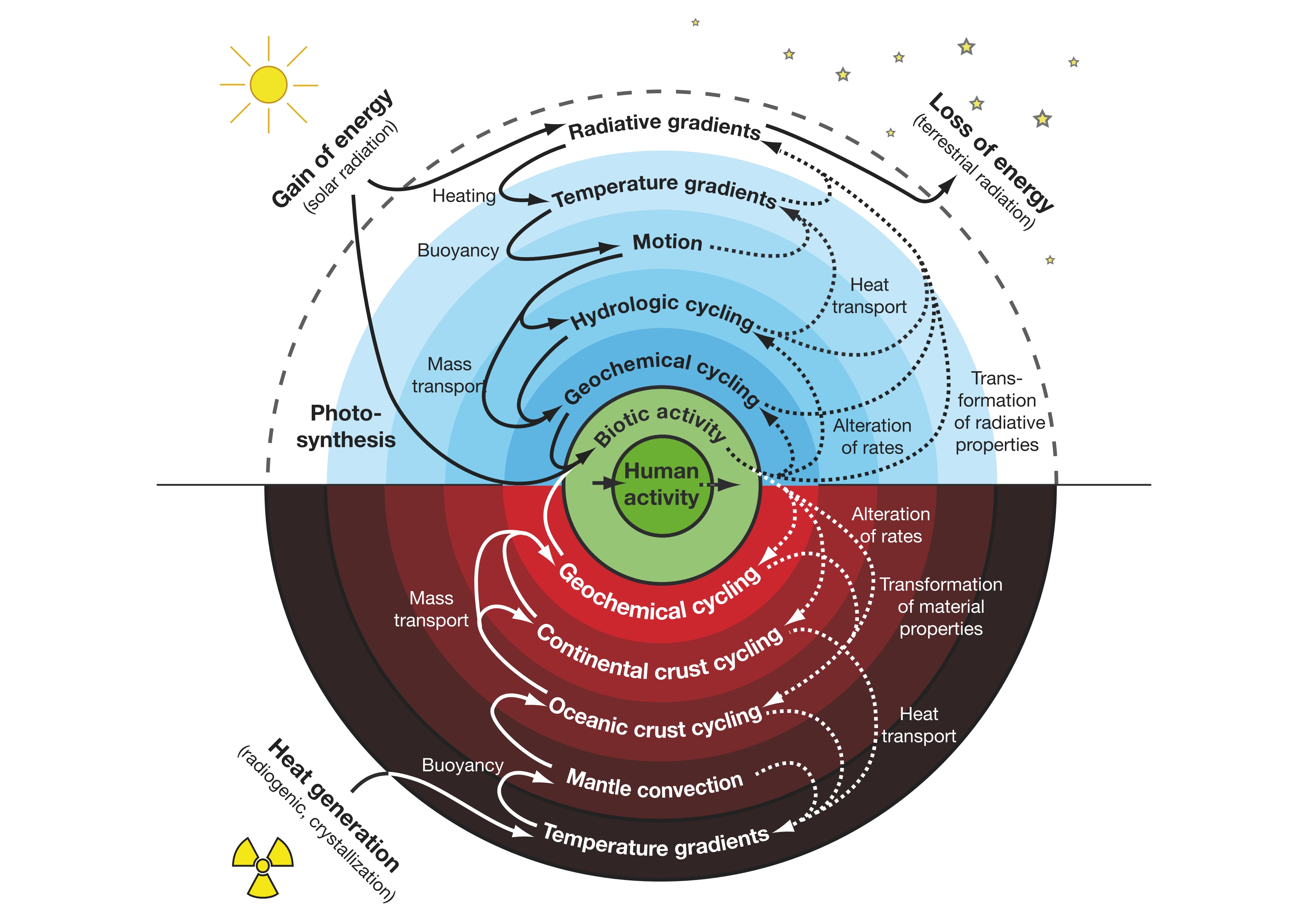
small
align-left
align-right
delete
I focus on the planetary scale because it makes it simpler to describe the behavior of these processes. This may seem counterintuitive. At first, one may assume that the highly complex dynamics of many actors—such as whirls in a turbulent flow, producers and consumers in ecosystems, or humans and technical objects in societies—should result in even more complex behavior at the planetary scale. That is, larger scales involve more actors that can interact in more diverse ways. However, when energy is constrained, simplicity can emerge at larger scales within highly complex systems, of which there are well-established examples. I focus on such energy constraints in the following to justify the focus on the planetary scale in a comparatively simple way.
Thermodynamics Sets the Laws
Energy constraints emerge from the fundamental theory of thermodynamics that sets the basic laws for energy conversions. The first law states that energy is conserved when it is being converted, while the second law states that energy becomes increasingly dispersed, as measured by the physical concept of entropy.
These laws are fundamental, but they can also be experienced in everyday life. When I start my day with a hot cup of coffee, the inevitable will happen: the coffee will get colder. What actually happens is that the heat, or thermal energy, within the cup and my office are spread more and more evenly, which eventually results in equal temperatures in both (and cold coffee). During this redistribution, energy stays conserved (the first law), but the entropy increases (the second law). The increase in entropy caused by a process that spreads energy is a fundamental consequence of a process being active. This happens not only with cups of coffee, but with all processes in the Earth system. The increase of entropy sets a fundamental direction for anything that happens on Earth, and the speed at which it happens tells us about the overall activity. All processes follow these laws—the climate system, the biosphere, humans, and the technosphere—with no exceptions.
The second law sets more than just a direction. It sets limits to how much free energy, such as electric energy that is able to perform work and maintain activities, can be generated. This is, of course, directly relevant to the technosphere, as human-made objects require such energy to actually do things and stay active rather than to just sit idle and do nothing. This limit can be illustrated by a power plant. A power plant generates electric energy out of heat. The heat is generated by combustion of a fuel such as coal at a high temperature, which is energy of low entropy. The heat that leaves the cooling towers of the plant, seen in the form of white clouds emerging from their tops, exits the power plant at a much colder temperature, and hence at higher entropy. According to the first law of thermodynamics, energy needs to be conserved, so the heat created by combustion balances the heat lost through the cooling towers and the electric energy being generated. The second law tells us that not all of the heat from combustion can be converted into power. A substantial percentage needs to leave the cooling towers, so that in sum, at least as much entropy leaves the power plant as enters it through the combustion process. In the ideal case, these two rates are equal, which defines the well-known Carnot limit, which is a direct consequence of the first and second laws of thermodynamics. It applies not only to power plants, but also to solar panels and to how the Earth generates different forms of energy, for instance when it generates atmospheric motion out of heat. More generally, this limit sets an upper bound to how active a process can be.
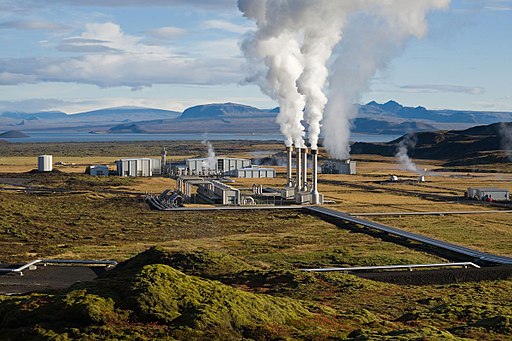
large
align-left
align-right
delete
The Sun Energizes the Earth System
When we apply the laws of thermodynamics to the Earth system, it is the continuous input of energy by sunlight that keeps the Earth active. Sunlight is radiation in the visible range of wavelengths. It has a very low entropy because it has been emitted by the Sun at a high temperature. After it has been absorbed, converted, and redistributed within the Earth system, it is emitted to space at much lower temperatures, having longer wavelengths in the infrared range and higher entropy. It is this difference in the entropy of the radiation Earth receives and that it emits that allows for substantial energy conversions and for Earth to stay active.
One set of energy conversions keep the climate system active, with organized circulation patterns of atmospheric winds, oceanic currents, and hydrologic cycling. The different forms of energy are generated by sunlight heating the Earth unevenly, thereby creating temperature differences. These temperature differences generate the kinetic energy of atmospheric motion, just like how a power plant uses the temperature difference to generate electricity. The result of motion is that the heat it transports reduces these temperature differences, which lowers the ability to generate kinetic energy. Simple considerations demonstrate that the atmosphere operates near its thermodynamic limit of maximum power, generating as much kinetic energy as possible, working as hard as it can, and thus staying as active as possible. It suggests more generally that not only do thermodynamic limits exist within the Earth system, but that they are highly relevant because physical processes actually evolve to and are maintained at these limits.
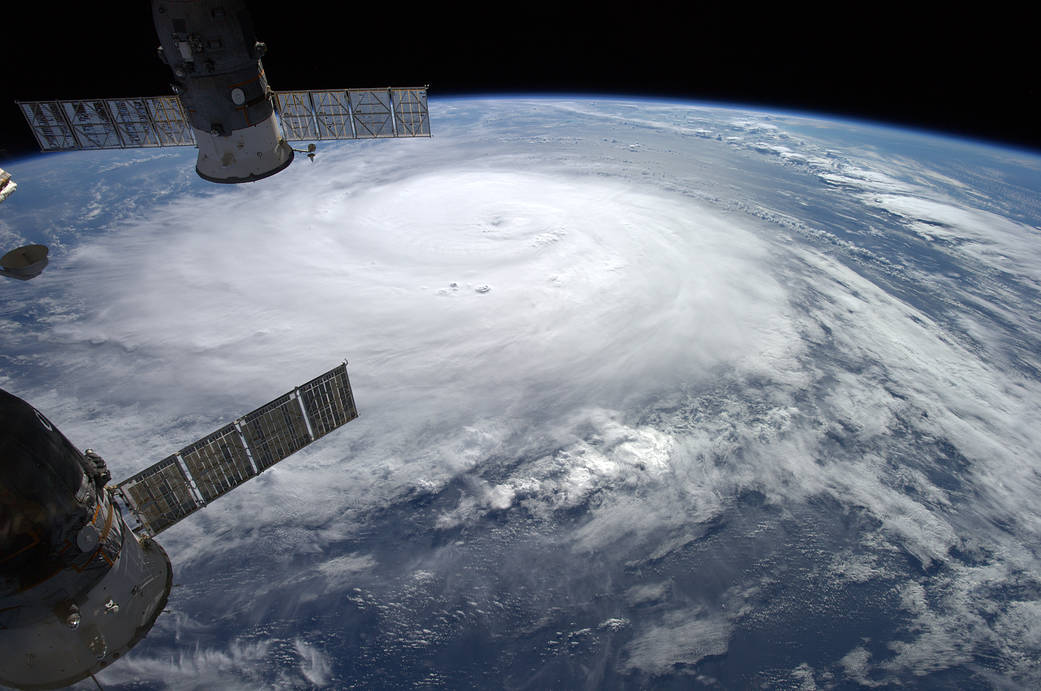
large
align-left
align-right
delete
Motion, in turn, provides the means for further energy conversions. Upward motions cool air, bringing moisture to its saturation and causing precipitation, thus driving hydrologic cycling. The precipitated water on land dissolves minerals of the continental crust, thus driving geochemical weathering. Yet the rates at which energy is converted and sunlight is utilized are comparatively small. The whole atmospheric circulation, for instance, operates by converting less than 1 percent of the incoming solar radiation into the kinetic energy associated with motion. This is because much of the potential of solar radiation to perform work is lost when it is absorbed and converted into heat. The resulting temperature differences on Earth are small compared to that of a power plant, meaning that relatively little power can be generated.
With photosynthesis, life created an innovation, because this process does not use heat and temperature differences as a means to generate energy. Instead, it uses the low entropy of sunlight directly. Photosynthesis uses visible light to split water first into hydrogen and oxygen, and then the hydrogen further into its proton and electron. This generates electrical energy that the plant uses to generate chemical energy in the form of carbohydrates and atmospheric oxygen. Photosynthesis generates energy more efficiently than the physical climate system, yet it is nevertheless only able to convert at best 3 percent of the energy contained in sunlight. In many regions, biospheric activity is further limited by environmental factors. In the oceans, the replenishment of nutrient-depleted surface water with nutrient-rich water from the deep ocean limits the supply of nutrients to photosynthesizers, while on land, the supply of water by precipitation is a major limitation. This leads to a strong imprint of climate on patterns of biological productivity, and it makes the ability of the biosphere to generate energy dependent upon the work of the physical climate system.
The energy generated by photosynthesis feeds the food webs of natural ecosystems, but also geochemical reactions in the Earth system. In fact, life produces more than ten times the chemical energy than abiotic processes, such as stratospheric ozone chemistry and geochemical weathering. Life thus plays a dominant role in shaping the geochemical composition of the planetary environment. This effect on the geochemical composition feeds back into the planetary system because the atmospheric composition affects how well radiation is absorbed and emitted. This, in turn, alters heating and cooling rates and thereby the boundary conditions that determine how active the physical climate system can be. As climate limits biospheric activity, a positive feedback loop emerges by which life changes planetary geochemistry, which alters climate, which then allows the biosphere to become more active. This is probably the dominant feedback loop that shaped the evolution of the climate-biosphere system over the Earth’s history. It likely evolved the biosphere to become more and more active, which allowed it to become increasingly more complex and diverse.
Human Energy Consumption is a Planetary Process
To stay active, humans and the technosphere consume the energy generated by these Earth system processes just described. The calories in food come from the harvest of photosynthesis from croplands and, indirectly, from animals that graze on pastures. The energy that fuels the technosphere comes primarily from fossil fuels, stocks of energy contained in plant residues from millions of years ago that did not get decomposed because they were locked away by geologic processes.
To place these two forms of energy consumption by human activity and the technosphere into a quantitative context: the average human metabolism of a 75 kg human consumes about 100 W; multiplied by 7.7 billion people, this yields a consumption rate of about 0.8 x 10^12 W (I refer here to 10^12 W (watts), or 1 TW (terawatt), because this is a typical number for energy conversions at the planetary scale). More energy from the biosphere than the human consumption rate is required to meet this demand, because only a small fraction of plant tissues is suitable to be digested by humans. The use of animal products includes further inefficiencies, as additional energy is needed and consumed to sustain the metabolic activity of the livestock. Estimates place the actual use of photosynthesis for the metabolic needs of humans at about 8 x 10^12 W, which represents about 5 percent of the energy generated by photosynthesis on land.
The activity of the technosphere is primarily driven by fossil fuels, or, more generally, by its primary energy consumption. In 2017, this primary energy consumption was on average 18 x 10^12 W, or 18 TW. The technosphere’s energy consumption is twenty times more than the metabolic energy needs of humans. Just the sheer proportion of this rate shows how essential the technosphere has become in human lives. This rate also shows how relevant the technosphere is within the Earth system. The technosphere consumes more energy than, for instance, the power that mixes the world’s oceans, which is about 5 x 10^12 W. It substantiates the notion that we have entered the geologic era of the Anthropocene. Human activity and the operation of the technosphere consume energy at rates that are similar or even greater than those of natural processes in the planetary system.
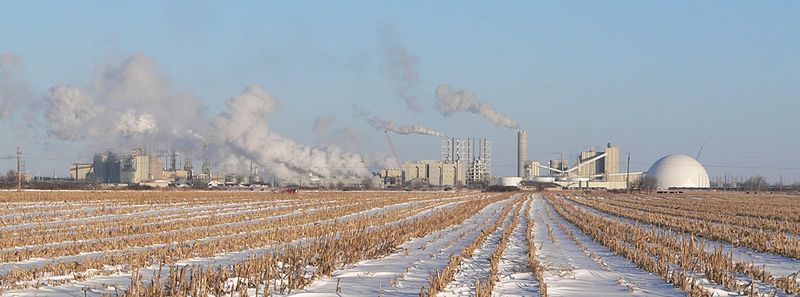
small
align-left
align-right
delete
Humans Perform More Work with Less Effort with the Technosphere
We can next ask about the role that the technosphere plays in human lives and in the Earth system in general. The energy being consumed by the technosphere drives several purposes. It feeds power plants and converts energy into electricity. It fuels cars and jet engines for transportation. It makes our environment more comfortable by lighting, heating, and cooling. It allows humans to communicate over distances, organize and store their knowledge, and do advanced computations using smartphones, computers, and the internet. While all of these examples clearly need energy, it is not immediately apparent what their overall role is within the Earth system.
To identify such a general role, let us take a step back in history. A primary, essential activity of humans is the acquisition of food. This is, after all, the energy needed to sustain our metabolisms and is thus a very basic need that comes in first place. While this activity forms a dominant part of the lives of hunter-gatherer societies, the cultivation of plants and the onset of agriculture a few thousand years ago allowed humans to produce more of the calories they needed with less effort. The surplus allowed for the development of other jobs as well as cities and trade networks.
With industrialization, food production changed again in a substantial way. The external energy input by fossil fuels produces mineral fertilizers and runs machinery such as tractors and harvesters. It reduces the need for these jobs to be done by nitrogen-fixing plants or by humans. More generally, it represents an externalization of human work that is done by the technosphere, resulting in increased food production with less human effort. Humans no longer need to plow their fields, and neither is this done by oxen or horses. Tractors do the job faster and more powerfully. Overall, this suggests that the technosphere allows humans to accomplish more with less effort in general. This allows human activity to focus less time on food production and more time on advancing the technosphere.
Yet, the beneficial effects of the technosphere come at an energetic price. A tractor that sits idle in the shed does not contribute to a benefit in food production. It needs energy to run. This ability of the technosphere to benefit humans comes at the price of requiring external energy input. This external energy input at present comes from fossil fuels. The use of fossil fuels are clearly not sustainable, because their geologic stocks will eventually deplete and, with them, the external energy supply to the technosphere that is vital to keep it active.
This lack of sustainability is an inevitable outcome of finite stocks. A shift away from fossil stocks is likely to take place long before they run out because of the detrimental effects of the global warming that is intimately connected with the burning of fossil fuels. These negative effects demand a shift toward a sustainable energy supply for the technosphere that is based on renewables or fusion energy. Both technologies are part of the technosphere, so in this sense a suitable evolution of the technosphere is required to accomplish this shift.
The Technosphere Can Take the Earth to Its Next Level
From the viewpoint of thermodynamics, one can very well imagine that such a shift toward sustainable energy consumption is likely to happen in the future, and one can anticipate the means by which it can happen. Such a trend would follow the thermodynamic imperative that systems evolve toward maximizing power, thus allowing for maximum activity, by altering the boundary conditions of the system. For the technosphere, this translates into the question about the means by which more energy can be generated sustainably that is more effective than the means already available as per the physical climate system and the biosphere.
A prime example of such a technology is photovoltaics. Just like photosynthesis, it uses sunlight directly to perform the work of charge separation to generate electric energy. Yet, in contrast to photosynthesis, a solar panel does not rely on sources of carbon, water, and nutrients to stay active, as it exports its energy solely in electric form (so it only needs a power line). Solar panels are vastly more efficient than photosynthesis, with current industrial-grade solar panels operating with efficiencies close to 20 percent. The theoretical limits of using sunlight at more than 70 percent efficiency will allow for further technological advancements and higher efficiencies.
At 20 percent efficiency, it would take an area of about the size of Germany, or 400 000 km2, covered with solar panels to generate 18 TW of solar power. This is a tiny fraction of the 19 million km2 of barren land available on Earth, and this land could be used for such fields of solar panels to meet the human energy demand. Imagine how easily much more energy could be generated for human use just by using a fraction of the world’s deserts. Naturally, these areas have no water to sustain productivity, so the potential of sunlight to generate free energy is wasted when it is absorbed and turned into heat. Large-scale use of photovoltaics in these areas would start making the technosphere a producer of energy, rather than merely a consumer of energy that has been generated by other Earth system processes, either in the form of stocks of fossil energy or stocks renewed by the Earth, such as wind energy and hydropower.
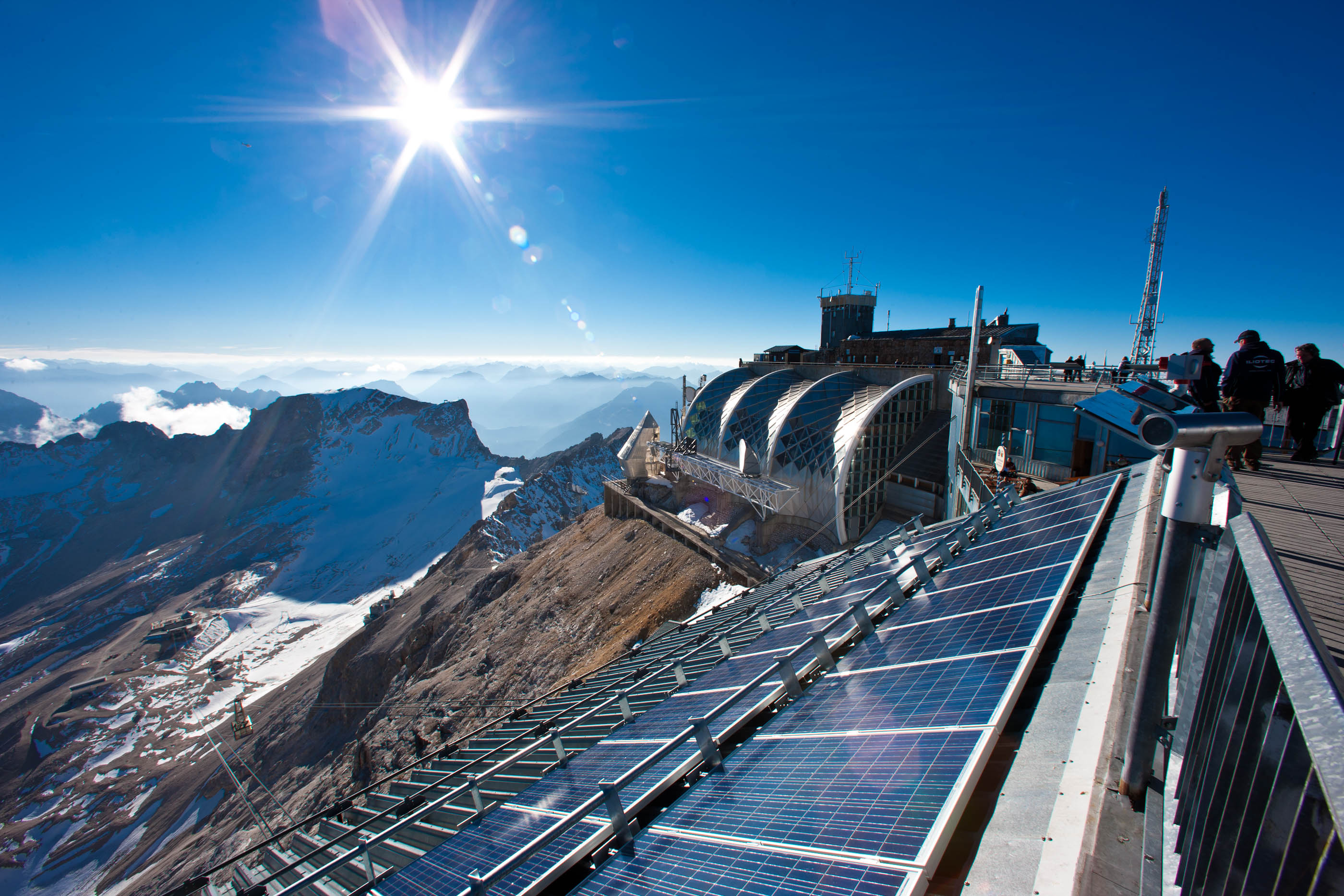
large
align-left
align-right
delete
This additionally produced energy by the technosphere could empower the whole planetary system. It could be used for desalination technology to sustainably provide more fresh water—more than the natural hydrologic cycle can provide, as the climate system accomplishes this desalination work rather inefficiently. The energy could be used to do agriculture in the form of vertical farming, growing food in warehouses on multiple shelves with artificial lighting and closed and controlled water and nutrient cycling. It could take food production to unprecedented levels, reducing the agricultural demand for suitable land and allowing for more ecosystems to remain in their natural state.
This evolution would clearly make Earth look different. It would become a planet that not only has a technosphere, but has a technosphere that plays a dominant role as a producer of energy. The human species alone cannot accomplish this task because, by nature, humans are consumers of energy, not producers. Solar-based technology that is more efficient than natural photosynthesis is needed for this evolution to take place.
Thermodynamically, this evolution would progress the Earth to its next level. As more of the incoming solar radiation is converted into free energy that can perform work, rather than just heat, it can sustainably fuel more activity of humans, of the technosphere, and of the whole Earth system than at any time in the planet’s past. The ability for more physical work can maintain a more organized state, reflected in more organization and physical structures, such as urban, transportation, and communication network structures that require work to be built, maintained, and used.
In moving Earth to its next thermodynamic level, humans and their technosphere would follow in and extend the footsteps of complex physical and biological systems that become more organized when they are able to perform more work. Such an organization of working systems is, for instance, reflected in the whirls in turbulent flows and in the vascular networks of river systems and plants. This pathway follows the ultimate thermodynamic imperative to evolve to states of greater energy conversions and higher levels of entropy production at the planetary scale, but in ways that are impossible to evolve by purely physical or biological processes. The Earth system thus needs the technosphere to make this evolutionary step to the next thermodynamic level of greater energy conversions.